May 10, 1979
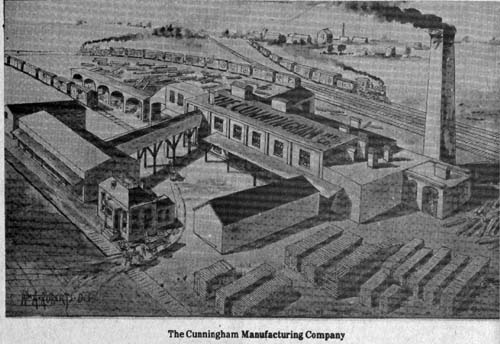
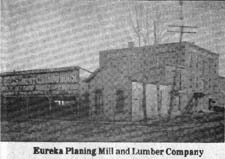
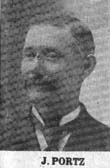
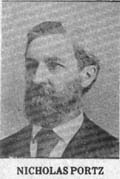
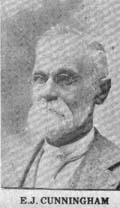
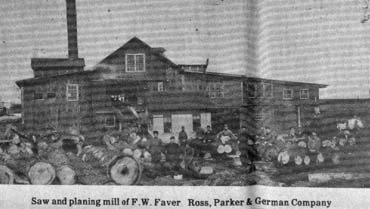
Picture #1 – The Cunningham Manufacturing Company
Picture #2 – Eureka Planning Mill and Lumber Company
Picture #3 – J. Portz
Picture #4 – Nicholas Portz
Picture #5 – E.J. Cunningham
Picture #6 – Saw and planning mill of F.W. Faver Koss, Parker & German Company
The story about Fostoria’s oldest industry…Seneca Lumber, calls for a sequel about other lumber and woodworking factories which sprang up in Fostoria in the last century and continued to exist for many years. Today, they are all gone.
However, the PK Company, located on West North Street occupies the site of one of those early companies…Koss, Parker and German Lumber Company.
The Wedge Lumber and Supply, on Ohio 12 west, which started it’s business in 1935 is the only other supplier in Fostoria.
KOSS, PARKER AND GERMAN
The Koss, Parker and German Lumber Company was formed by a group of Fostorians in 1894, when Fostoria was in its hey-day. It was located where the PK Company is now on West North Street, and occupied buildings on both sides of the street. It may have been an outgrowth of Koss, Monler and Co., which started a mill at 227 W. High St. in 1890; the principals being Fred Koss, who lived at 120 W. Crocker St.
Like most of the lumber companies of that day, they manufactured sash, blinds, doors, mouldings and other wood products, for sale in the Fostoria area, but also shipped to eastern markets. They also specialized in veneered work. At peak periods they employed 50 people.
Mr. Charles W. Koss, the president lived at 219 N. Poplar St., and his children Fred and Louise were my playmates until lumber company changed hands and the family moved to Toledo.
Charles E. German, another principal, was active in Fostoria affairs, and the father of Rudolph and Herbert, both musicians under Wainwright. They lived at 255 W. Tiffin St.
Evidently L.R. Parker had left the company by 1913, since a city directory listed him as a dealer in lumber at his residence 586 Maple St. He lived at 447 Columbus Ave. in the 1890’s.
The company became known as Koss and German Lumber Co. after Parker left it. The only other data I could uncover about Parker, other than his lumber experience was that he served as a councilman for three terms, and was vice-president of the Board of Trade.
Eventually, the lumber company was sold to a large out of town company and was called Fostoria Lumber and Supply Co. J.O. Slosser was superintendent. Fire destroyed the main building in 1928, but it was rebuilt. The millwork building of the original company still stands on the triangle formed by North Street and the old LE and W railroad bed. That building is now owned by Mr. and Mrs. William Weinandy. Mrs. Weinandy operated a beauty shop there.
EUREKA LUMBER
The Eureka Planning Mill and Lumber Co. was started in 1887, and managed by John Portz, who resided at 123 N. Countyline St. Although a native Fostorian, he had been engaged in the lumber business in Sycamore, Ohio. Others who were associated with the company were: Fred Manecke, who resided at 335 N. Main St.; Ira Cadwallader, 231 E. Tiffin; J.A. Boley, 225 E. Crocker.
The mill was located at the corner of East North and Cadwallader streets. The buildings are still standing, as part of the Gray operation.
Eureka manufactured doors, sash, blinds and did custom wood work for the growing Fostoria.
Around 1912-15 when my family moved to the corner of McDougal and Cadwallader my recollection is that the Portz family was still connected with the mill; and I do remember Fred Manecke who by then was quite elderly, still was connected with it. I presume Cadwallader was also still interested in it.
As a boy I used to retrieve wood scraps from the mill to make various things I dreamed up.
In the late 1920’s or early 1930’s the mill was purchased by the Lacost family…C. Tracey and Charles T. Lacost (Mrs. Joe Murrin’s family) who owned three other mills and lumber yards in this area. The mill was renamed East North Street Lumber Co. and was managed by Carl Oyler. After Oyler passed away, Joe Murrin became manager. It continued to operate until 1964, when Gray Printing purchased the property.
F.W. FRAVER SAW AND PLANNING MILL
This mill was located at the corner of McDougal and Town street, northeast corner. They manufactured sash, doors, building materials. Twelve men were employed year-round, and business was done throughout Seneca County. This mill was bought and consolidated with Seneca Lumber around 1900.
Frederick W. Fraver, originator of the saw mill, was the son of John Fraver, who immigrated to this country from Germany when only 18 years of age.
Frederick Faver had only one child, a daughter Bertha. The family lived at 334 E. Fremont St. In his declining years, after he was retired from the mill, he lived with his daughter, Bertha Merchant at 419 S. Main St.
None of Frederick’s descendants are living. The oldest living descendent of any part of the Fraver family is Ollie Fox, daughter of William Fraver. Mrs. Fox still resides in Fostoria.
Ivan Fraver, son of Andrew Ulysses Fraver, one of the second generation Fravers, still resides on a farm on McDougal Road, which is part of the original John Fraver farm. Ivan and his son Daniel, the youngest of the family with the Fraver name, farm 600 acres east of Fostoria.
CUNNINGHAM, PORTZ AND COMPANY
Cunningham, Portz and Co. was originally organized in 1869 by E.J. Cunningham Nicholas Portz and others, possibly Charles Foster, since according to old records, Portz and Foster were associated in various business deals for more than 50 years.
In 1882 the plant was rebuilt and became known as The Cunningham Manufacturing. The location of the company was 228 Findlay St.
A peak capacity they employed 40 people making shipment to all parts of the country, but mainly eastern markets.
E.J. Cunningham, the president of the company had charge from 1876. His son E.K. Cunningham was secretary of the company at one time.
OTHERS
Others in the lumber and mill business in Fostoria many years ago were: B.F. Histe-Hard and Soft Wood Lumber, 157 Elm St; Campbell and Co. Sash Factory, 143 W. North St; Green and Heilman Planning Mill, established in 1873 by Martin V. Green and J.F. Heilman. They employed 12-15 men.
Edward J. Cunningham was born in Berkely County, Va., November 4, 1831, to Levi and Alcinda Cunningham.
At the age of fifteen he entered a grist mill to serve as apprenticeship at the milling rade, remaining until 21 years of age. In 1852 he came to Tiffin, where he worked at his trade for his brother J.W. Cunningham until 1854, when he sent to Cambridge, Ind., and followed his trade there for one year.
He then returned to Tiffin, and with his brother operated several mills, namely the Shoemaker Grist Mill, Keller Mills and Clifton Mills.
Coming to Fostoria in 1863 he built the Union Mill, later to be known as the Livingston Roller Mill. He later sold it to William Grapes. Still later, he and Charles Foster repurchased and operated it four years.
In addition to his interest in the Fostoria Stave and Barrel Co. he was president of Cunningham Manufacturing Co. which made wood spokes and other wood products of all kinds, employing approximately 40 people.
He also organized The Commercial Bank and Saving Co.
Local history buffs will also be interested to know that E.J. Cunningham and Major George W. Cunningham were brothers, and married Keller sisters… Edward marrying Ann Elizabeth, who was married to Charles Bribble, another well-known Fostorian of the past.
Other descendants of the Edward Cunningham were: Minnie, who married Stokes Tunstill and had one daughter Clara, married to Richard Kelley; Cora, married to John W. McDonel, no children; and Ralph and Earl Cunningham, both well known Fostorians of the past who never married.
PORTZ FAMILY
John and Magdalene (Bohna) Portz, natives of Prusia, emigrated to Jackson Township in 1838 and to Fostoria in 1840. Nicholas Portz, their first son, was born in Jackson Township in 1839. A second son, John was born later. The elder Portz was a wagonmaker by trade.
Nicholas Portz, at the age of 12, began to clerk for C.W. Foster and Son. In 1863 he became affiliated with the firm of Foster, Olmstead and Co., and in 1867, he with Charles Foster, organized the N. Portz Hardware Co.
For many years he was general manager of The Fostoria Brass and Iron Works Co. After it went out of business he purchased the machinery and stock of the I.B. Potts pipe fittings, established a plant in Fostoria and shipped the product to every state in the Union and Mexico.
Nicholas Portz was the first president of Fostoria’s Board of Trade. Through his efforts and that of Charles Foster, the Nickle Plate Railroad was influenced to come through Fostoria.
He built the property which is now the location of Mann Funeral Home. Portz lived there for a time, then sold it to the G.G. Gillette family, who later sold it to George M. Gray who lived there until his death.
John Portz, the second son of the elder Portz, was connected with the Eureka Planing Mill, reported elsewhere in today’s article. The only living male descendent of John Portz II is John Portz III, living in California. He is a cousin to Marjorie Newhouse, West Fremont Street.